库存控制方法的 51 条专家提示:选择库存控制方法、数据收集和分析技巧以及实施合理的库存控制策略
库存控制对于各个行业的企业来说都是一项关键功能。如果没有有效的库存控制方法,供应链就会受到影响,您无法充分满足客户需求,最终,您公司的底线将反映这些不足。
但是选择正确的库存控制方法并制定有效的政策确保遵循流程、提高库存控制方法的准确性以及收集准确的数据以了解如何使用这些数据通知业务的其他领域,这些都是没有简单、全面的解决方案的问题。
这就是为什么评估贵公司当前的业务场景以识别关键需求并选择最能满足这些独特需求的系统和开发流程对于首次选择库存控制系统的公司来说通常是必要的第一步。公司定期进行这些审计也是一个好主意,以确保当前的系统和流程充分考虑组织内发生的增长或变化。
帮助公司选择或开发非常适合业务的方法根据要求,我们编制了一份关于库存控制方法的 51 条专家提示列表,从帮助您选择正确的库存控制框架或方法的信息到了解贵公司独特的业务需求以及创建和执行有效的库存控制政策。要浏览特定部分中的提示,请使用下面的链接导航到每个类别。
跳转到:
- 选择正确的库存控制方法
- 库存控制基础知识
- 有效库存控制的数据收集和分析技巧
- 了解您的库存和公司的需求
- 制定有效的库存控制政策
选择正确的库存控制方法
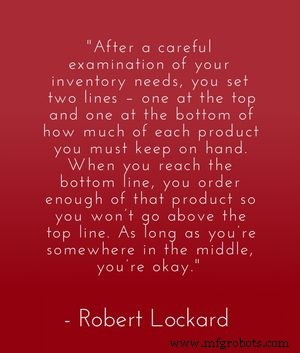
1。最小-最大库存控制方法可帮助您定义应为特定项目维护多少库存。 “在仔细检查了您的库存需求后,您设置了两条线——一条在顶部,一条在底部,以说明您必须保留的每种产品的数量。当您达到底线时,您订购了足够的产品,这样您就不会超过顶线。只要您处于中间位置,就可以了。
“优点:这种方法很简单,它使平衡库存的任务相当简单。
“缺点:它的简单性可能会导致麻烦,因为您可能会订购太多产品或在它们到达之前用完。” – Robert Lockard,您需要了解的 4 种库存控制方法 ,库存系统软件;推特:@Fishbowl
2. ABC 方法是某些行业最常用的库存控制方法之一。 “这是零售行业常用的方法之一,有时与其他方法结合使用,以更好地控制库存。这更像是一种库存分类技术,根据产品在其分类计划中的销售贡献和重要性对产品进行分类。
“A-类别产品将是销售量最大的杂货商和利润率更高的旗舰产品.通常,占总销售额 80% 的分类中前 20% 的产品被归类为 A 类,需要严格控制库存以确保不会出现销售损失。 20% 的产品贡献了 80% 的销售额,这被称为 80-20 规则或帕累托原则
“C 类产品是对销售额贡献较小的底线。这些物品对企业来说并不重要,并且仅出于客户需求的目的而保留。
“B 类产品对零售商很重要,但与 A 类产品相比则不那么重要。” – Suresh Ram,库存控制系统的类型 , 详细讨论零售
3.供应商管理库存是某些行业的一种选择。 “顾名思义,供应商管理库存 (VMI) 是由供应商(供应商)管理的库存。虽然可能不止于此,但至少这意味着供应商决定何时补货和补货多少。
“供应商管理的库存并不是什么新鲜事;事实上,它已经存在了很长时间,而且比你想象的要普遍得多。如果你曾经在餐馆工作过,你会每天左右看到“面包人”出现,检查你的库存(亲眼看看你的面包、小圆面包等),然后去他的卡车上给你存货.在理发店,你的理发师(是的,我是老派,我去理发店)销售或使用的许多美发产品也由供应商管理。在这种情况下,实际“管理”库存的可能是该产品的销售代表,他可能会从汽车后备箱为理发店补货。在旧的独立五金店,螺母、螺栓、垫圈、O 型圈等物品通常由供应商管理。在较大的企业中,您的运输纸箱、办公用品或清洁/维护用品可能由供应商管理。” – Dave Piasecki,供应商管理库存 (VMI):它是什么以及何时使用它有意义 , InventoryOps.com
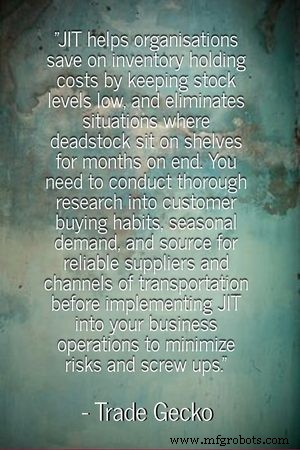
4.即时库存控制方法被认为是一种冒险的做法,但它确实减少了企业的库存量,从而可以降低间接成本。 “即时 (JIT) 方法可以减少企业手头的库存量。它被认为是一种有风险的技术,因为您只在需要分发或销售的前几天购买库存,以便物品及时到达以供使用。
“JIT 通过保持库存水平帮助组织节省库存持有成本低,并消除了滞销商品连续数月搁置在货架上的情况。在将 JIT 实施到您的业务运营中之前,您需要对客户的购买习惯、季节性需求以及可靠供应商和运输渠道的来源进行彻底研究,以最大程度地降低风险和搞砸。” - 库存管理技术 , 贸易壁虎;推特:@tradegecko
5.多期库存方法主要有两种变体:固定订货数量和固定时间段订货。 “多期库存模型可以有两种变体。固定订单数量系统是每次下达固定数量的订单。当事件发生时下订单完成 - 例如达到最低库存水平。第二个变体是固定时间段模型,其中在特定时间下订单,例如当每月对库存水平进行审查时。订单量将取决于所需的库存量。
“这些模型之间的主要区别在于,在固定订单量模型中,必须持续监控以确保在库存水平达到一定水平时下订单。降低到适当的水平。固定时间段模型中的库存水平仅在应下订单时检查。在固定订单数量模型中,库存水平通常较高,该系统往往用于更昂贵、更重要的物品。它也需要更多的时间来维护,因为库存模型需要不断测量。
“固定订单数量模型用于非常稳定的情况,即产品需求恒定、产品提前期已知且可靠、价格不变,订购成本是恒定的,所有产品订单都将被执行。” – Peter Carr,第 7 周:库存管理 , BE 603 运营和供应链管理(由滑铁卢大学康拉德商业创业和技术中心提供);推特:@UWaterloo
6.最有效的库存控制方法可能因公司而异,甚至针对单个商品类别。 “库存控制方法因公司而异,商品因商品而异,SKU 因 SKU 而异。最适用于慢速商品的库存控制方法可能不适用于快速移动的商品。一家公司可能有 100 万个不同的 SKU,并且只使用五种不同的库存控制方法。要记住的一件事——没有完美的方法来管理库存。不存在导致完美库存水平的圣杯或魔法公式。公司只能寻求找到能够降低成本和提高服务水平的最佳方法。” – Kenneth Hamlett,库存控制方法 , Chron.com;推特:@HoustonChron
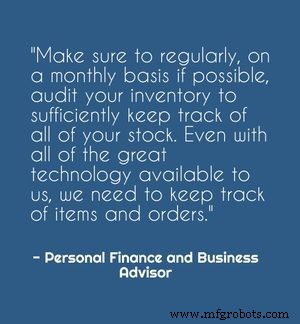
7。虽然不一定有一种万能的库存控制方法,但制定清晰的库存控制系统和相关政策对于任何公司的成功都是必不可少的。 “要了解各种库存管理技术,了解其重要性至关重要。
- 首先,库存管理不善会导致营运资金不必要的增加。多余的资金本可以有效地用于推动公司的增长计划或研发工作。
- 其次,有效的库存管理会降低仓储成本,进而提高公司的利润。存储空间昂贵;如果您能够很好地管理您的库存并能够减少您需要存储的商品数量,那么您将需要更少的空间,从而降低仓库租赁成本。
- 第三,它可以帮助您以最快的方式向客户提供他们需要的产品,从而让他们满意。库存管理不善会导致商品可用性降低和交货时间延长。因此,如果您想获得这些服务满意度之星,则需要妥善管理您的库存。
- 第四,长期存放在库存中的商品可能会变质。这会导致经营业务时产生不必要的开销。因此,适当的库存管理可以帮助您大大降低这些成本。
- 第五,如果您的库存分散在不同的地方,您需要一个适当的系统来根据需求和供应来管理这些库存。库存管理技术可以帮助您管理多个库存。” – Laran Joseph,库存管理技术及其重要性 ,Udemy 博客;推特:@Udemy_Blog
8。寻找关键功能来评估允许您以数字方式管理公司库存的系统。 “不,我们不是说使用 Excel 来跟踪您的库存。我们指的是适用于您的业务的库存管理解决方案。并非所有程序都适用于所有人,因此请花一些时间评估特性和功能,以确保它满足您的需求以及您的业务需求。以下是评估库存管理系统的一些重要技巧。
- 基于网络: 拥有一个基于网络的解决方案将被证明是无价的。这种类型的库存控制系统通常更适合预算,提供更多功能并且通常更易于实施。
- 移动广告资源: 您可以随身携带库存管理系统吗?仅基于网络是不够的,因此请确保您的系统兼容 iPad、iPhone、Android 或 Windows Mobile。
- 条码集成: 条形码可让您减少数据输入错误,加快库存控制流程,同时让您的日常操作更轻松。
- 计量单位换算: 使用了解您的采购计量单位的系统通常与您的库存计量单位不同,这一点至关重要。您可以从 Acme Supply 按“箱”购买您的“小部件”,但您可以按“每个”计量单位向您的员工发布相同的“小部件”。通常,您可能会看到这样一种情况,即在一个订购的“案例”中可能有 50 个“每个”。对于您的库存管理系统而言,了解和理解此流程至关重要。
- 数据导入: 最初导入您的数据将为您节省数小时,甚至数天的手工输入所有耗材。请务必检查此功能。
- 批处理: 没有人喜欢一遍又一遍地执行相同的任务;确保您选择的系统提供批量交易或批量流程,以便将大型工作转变为易于执行的任务。
- 周期/物理计数: 最终,您货架上的供应数量将不等于库存管理软件中该项目的数量,因此周期盘点或物理盘点您的供应需要快速而简单。确保您选择的系统提供了一种快速简便的方式来执行这些功能。
- 警报和通知: 自动了解低标准警报和其他各种系统通知。没有人喜欢惊喜,有了自动提醒,您再也不会感到惊讶了。” - 5 个简单的最佳库存管理最佳实践 ,工具包组;推特:@TheToolkitGroup
库存控制基础知识
9.您的库存控制系统应包含几个关键要素。 “每个零件操作都需要某种库存控制系统,其中应包含以下关键要素:
- 它必须提前警告零件人员库存即将耗尽。
- 它必须列出零件的历史购买价格,以便在价格发生变化时,经理能够调查问题并确定这种变化是价格上涨还是由于计费错误造成的。
- 它应该列出提供最优惠价格的供应商。
- 它应该提供过去的使用率,以便经理可以确定适当的库存水平。
- 应该尽可能少地写作,尤其是机械师。” – John Dolce,改善库存控制的 15 条技巧 , 公用事业舰队专业;推特:@UtilityFleetPro
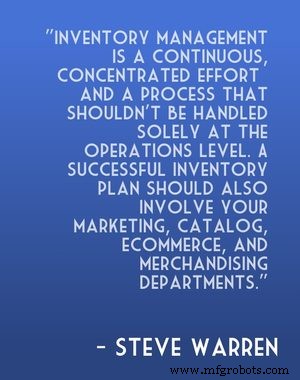
10.先制定计划,再执行。 “库存管理是一项持续的、集中的工作——而且是一个不应仅在运营层面处理的过程。一个成功的库存计划还应该涉及您的营销、目录、电子商务和销售部门。
“通过根据主要促销日历管理您的库存,每个人都会获胜:您的采购团队了解购买的时间和数量,您的履行情况供应商知道何时准备额外的仓库空间,您的联络中心工作人员可以预计呼叫量会增加。
“将往年的销售预测添加到您的库存日历中,以便为季节性需求高峰做好准备。” – Steve Warren,有效库存管理的 4 个技巧 , 多渠道商户;推特:@mcmerchant
11.确定维护库存的关键备件,并确保它们始终有库存。 “你确定你的关键备件了吗?关键备件 =长交货期(4-6 周) X 对生产设备至关重要 X 高零件成本。这些部分就像人寿保险。你希望你永远不需要它们,但如果你需要,它们最好放在货架上。” - 改进维护库存控制 ,马歇尔研究所;推特:@Marshall_Inst
12.应仔细审查发货,因为接收库存是损失的关键点。 “损失的一个关键点是在接收库存时。库存管理需要仔细检查装箱单以编目装运。您还需要在运输公司离开之前仔细检查物品,以防您需要提出损坏索赔。应仔细检查每批货物,这应包括计数产品并将其与装箱单进行比较。需要注意差异,如果需要,必须向负责发货的供应商提出索赔。” - 管理您的库存 ,白菜;推特:@KabbageInc
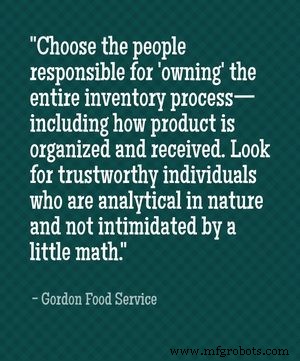
13.分配合适的库存管理团队负责您组织的库存控制流程。 “选择负责‘拥有’整个库存流程的人员——包括产品的组织和接收方式。寻找值得信赖的人,他们天生善于分析,不会被一点数学吓倒。” –改善运营库存和减少食物浪费的 7 个技巧 ,戈登食品服务;推特:@GFSDelivers
14.像库存一样,应该有一个单独的存储位置,必要时除外库存过多的位置。 “将类似的库存集中到一个存储位置。除非物理尺寸有限制,否则同一部件不应位于多个存储区域。在这种情况下,请将可用数量保持在最低限度,并将剩余部分移至不属于易于访问的存储位置(积压位置)。” – 实际盘点库存的仓库管理提示 , riteSoft
15.成功的库存控制是在库存成本和库存收益之间找到适当的平衡。 “成功的库存管理涉及平衡库存成本和库存收益。许多小企业主未能充分了解持有库存的真实成本,其中不仅包括存储、保险和税收的直接成本,还包括与库存相关的资金成本。保持过多库存和不足之间的细微差别并不是经理唯一关心的问题。其他包括:
- 维持种类繁多的库存,但不要将快速流动的库存分散得太稀少;
- 增加库存周转率,但不牺牲服务水平;
- 保持低库存,但不牺牲服务或性能。
- 通过批量采购来获得更低的价格,但最终不会导致库存滞销;和
- 手头有充足的库存,但不会被过时的物品困住。
“对于某些人来说,解决这些问题的成功程度比其他人更容易衡量。例如,计算库存周转率是衡量管理绩效的简单方法。该值为管理者设定目标和评估绩效提供了粗略的指导,但必须意识到周转率随库存的功能、业务类型以及比率的计算方式(无论是销售额还是商品成本)而变化卖)。个别行业的平均库存周转率可以从行业协会获得。” – 库存管理 – 成功的库存管理 , IPSCMI
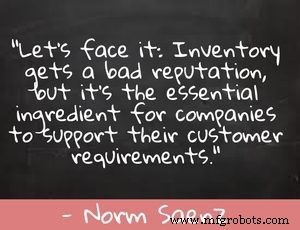
16.库存的名声不好,但它对几乎所有行业的业务来说都是一项关键功能。 “让我们面对现实吧:库存的名声不好,但它是公司支持其客户需求的基本要素。他们必须拥有目标客户所需的东西,才能保持业务并在竞争中脱颖而出。这最后一个事实是为什么这么多公司的库存在货架上保持缓慢移动或“死”库存。
“特定公司的库存要求因客户支持要求和制造商、零售商的业务类型而异、批发分销商或电子商务公司。即使在这些通用渠道类别中,药品/药品、食品、服装、日用百货、汽车、电子、建材和其他类型的业务在库存管理方面也会存在显着差异。
“而行业和服务库存水平影响库存实践,一些公司库存过剩的一般商业原因,例如供应链和供应商风险和不确定性;可变的客户需求和预测准确性;季节性均衡;交货期问题;价格对冲;失去忠实客户的风险;和营销以新商品推动销售。” ——St. Onge 董事总经理 Norm Saenz; St. Onge 的高级顾问 Don Derewecki,库存管理 101:是时候重新审视这些原则了 ,物流管理;推特:@LogisticsMgmt
17.糟糕的库存控制实际上是更深层次问题的征兆,例如糟糕的维护或设施管理计划。 “停机时间:这是维护和可靠性行业的每个经理都害怕的词。在最好的情况下,这意味着利润的损失。在最坏的情况下,这意味着失去工作。虽然并非所有导致停机的问题都可以完全避免,但了解哪些问题会有所帮助。在这篇博文中,我们将通过一些库存控制技巧来研究一些消除停机时间的可靠方法。
“您可能会问自己,库存控制与商店是否经历停机时间有什么关系,我会回答“很多”。糟糕的库存控制是更深层次问题的征兆,即糟糕的维护和/或设施管理计划。
“任何维护管理系统的关键步骤之一了解您负责的每一台设备。这还包括有关机器的信息,包括每个单元的年龄、供应商是谁、供应商联系信息、产品的预期寿命、建议的维护程序……不胜枚举。
“通过了解这些重要信息,您可以制定完善的维护计划,以确保您的设备继续正常运行,从而帮助避免未来可能出现的停机情况。” – Lisa Richards,使用这些库存控制技巧消除停机时间 , 地图控制;推特:@MAPCONtech
18.库存控制尽管很重要,但在某些环境(例如医疗保健提供者的办公室)中仍然是一项过时的功能。 “许多办公室没有库存控制系统,因此会遇到供应短缺,需要在最后一刻以高价订购。大多数实践负担不起或没有足够的容量来支持数字扫描仪控制系统。由于缺少物品而导致医生效率低下的成本通常高于供应成本。
“以下手动系统是一个简单易用的系统,它将库存控制权交给一个人,同时仍然允许办公室中的任何人在需要时使用耗材,而无需先与其他人核对。如果需要,也可以创建用于库存每个检查室或工作站的子系统。
“系统:
- 根据利用率和存储空间确定每件商品的购买周期(您购买它的频率:每周、每月、每季度等)。大多数办公室应每周或每月订购用品。如果您有用于检查室或工作站的子系统,那么您的周期将适用于从供应室重新储存这些区域。
- 确定每个购买周期中通常使用的每件商品的数量。
- 最初,购买足够的每件商品以维持两个购买周期,并为每件商品创建两个捆绑包。每个捆绑包都应包含足够的每件商品以维持一个购买周期(具有有效期的商品或季节性商品(如流感疫苗)除外)。用一根绳子或橡皮筋将每一捆包裹起来,或者将每一捆放在单独的盒子、袋子或其他容器中。为每个捆绑包附加一个可重复使用的标签,标签上标有商品名称、供应商、每件商品的最后支付价格、购买周期、订单金额和捆绑商品数量。
- 将标有“重新订购信封”的信封挂在显眼位置。把标签放在这里”在供应室。
- 当需要耗材时,任何员工都可以取用包裹,取下标签,然后将标签放入重新订购的信封中。应为访问的项目保留一个完整包和一个部分包。
- 指派一名库存控制员处理库存控制标签和标签,并根据采购周期订购新的供应品。如果您的店员在线订购商品,请让他或她检查在线供应商是否具有可以快速轻松地重新订购等于您的捆绑商品之一的功能。
- 货品到货后,应由库存控制员单独开货,将发货发票与原订单进行比对,确认准确无误,然后收货。
- 重新捆绑商品,并将使用过的标签重新附加到新捆绑商品上以完成订购周期。
- 将新捆绑的商品放在剩余捆绑的后面,如果对某商品的需求意外激增(例如,为了周转库存),该捆绑可能已经打开。
“您可以根据需要随时更改供应商、购买周期、订单数量和捆绑大小。只需更改标签以反映更改。” – Keith Borglum,问答:节省供应费用和控制库存的提示 ,现代医学网;推特:@MedEconomics
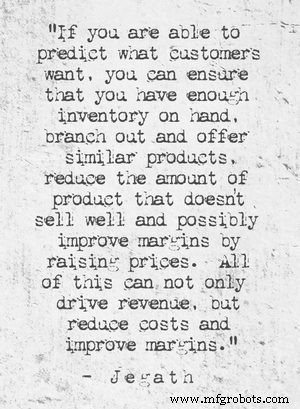
19.小型企业不应忽视对可靠库存控制系统的需求。在考虑方法和软件应用程序时,不要选择最便宜或免费的应用程序,而是选择一个可以随着您的业务发展的系统。 “你可能会想,既然你的生意很小,你不需要花很多时间和金钱来跟踪我的库存。以您的业务规模,您可以自己关注它,而无需设置特殊的系统。
“这种思路可能会给您带来麻烦。库存管理不仅仅涉及清点库存。一个好的库存管理系统还包括在将库存运送给客户时对其进行跟踪。从适当的库存管理中,您可以了解哪些产品卖得好,哪些卖得不好,这样您就知道要库存更多的东西,以及考虑出售哪些商品来转移它们。如果你能够预测客户想要什么,你就可以确保你手头有足够的库存,扩展并提供类似的产品,减少卖得不好的产品数量,并可能通过提高价格来提高利润率。所有这些不仅可以增加收入,还可以降低成本并提高利润。
“小型企业库存管理软件还可以帮助进行现金管理。通过了解哪些产品销售并使用它来控制您的采购行为以实现即时采购,您可以缩短业务的现金转换周期。同样,通过消除不销售的产品和 sku,您可以减少长期现金转换产品所占用的现金数量。所有这些对小企业来说都至关重要。问题不是“我是否需要库存管理系统”,而是“我应该投入多少金钱和时间”。然后你还需要考虑增长。以后切换系统可能会非常具有破坏性和痛苦。虽然您的小型企业可以使用免费的库存管理软件,但这可能不是最好的长期策略。最好购买可以与您一起成长的服务或产品。” – Jegath,给小企业主的提示:通过小企业库存管理软件增加收入 , 奥多罗博客;推特:@ordoro
20.对于维护组织来说,很容易陷入认为正确的 CMMS 也将解决公司的库存控制挑战的陷阱。但是,维护软件只能自动化和简化已经有效的流程。 “有效的库存管理是加快 CMMS 实施投资回报率的最佳方式之一。然而,跟踪库存可能是一项复杂而艰巨的任务。组织必须跟踪各种设备,以及用于正确维护这些设备的备件和工具。
“长期以来,组织不得不手动进行库存管理。当使用手动程序时,跟踪不同数量和不同特征的库存的难度会被放大。库存控制模块可以通过更好的记录保存和自动报告来简化库存管理。不幸的是,库存管理模块经常未被充分利用。
“许多维护经理错误地认为库存管理是维护管理系统的自动功能,但维护软件只能简化和自动化已经有效的流程。” – Carol Owens,使用维护控制软件简化库存管理的技巧 , Business-Software.com;推特:@BiznessSoftware
21.无论您采用何种库存系统、方法和政策,都应始终制定备份计划来保护贵公司的宝贵数据。 “保护你所有的辛勤工作。除非您制定了备用计划,否则即使是最高科技、最有组织的库存系统也可能发生灾难性的脱轨。例如,如果您最先进的计算机被盗或火灾损坏了您的设施,将您的书面记录变成一堆灰烬,该怎么办?通过将系统备份到其他地方来避免这种灾难性的情况,甚至可以备份到可移动的拇指驱动器上。” – Stephanie Howard,控制经理、供应商和库存的技巧 , 格罗夫夫;推特:@GroovvSolutions
有效库存控制的数据收集和分析技巧
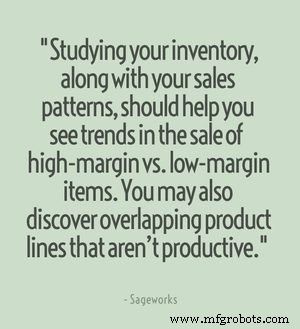
22.找到一种方法来评估哪些产品正在移动,哪些产品没有移动。 “使用库存信息的首要方法之一是按产品检查哪些在移动,哪些没有移动。 Doing this on an ongoing basis will help identify products that may need to be discounted in order to replace them with faster selling items or in order to generate some cash. Studying your inventory, along with your sales patterns, should help you see trends in the sale of high-margin vs. low-margin items. You may also discover overlapping product lines that aren’t productive.” – Sageworks, 6 Tips to Improve Inventory Management , Funding Gates; Twitter:@FundingGates
23. Measurement is essential. You cannot control what you don’t measure. “Metrics are essential to a well-run supply chain. Metrics for their own sake, however, are worthless. The purpose of a metric is to drive change when the variable you are measuring trends in the wrong direction.
“A number of different metrics are useful for inventory management. Days supply by product and location based upon forecast is an excellent metric at the SKU level.
“When analyzing roll-up numbers for a product line, warehouse, or any other higher level, however, days supply is misleading because the lows cancel the highs and hide imbalances. At the higher level, inventory velocity is a much better measure of inventory health.
“No metric is useful, however, unless it is acted upon. Constant vigilance and early response to imbalances are the keys to ensuring best-practice inventory management.” – Jane B. Lee, 8 Common-Sense Rules for Inventory Management , Inbound Logistics; Twitter:@ILMagazine
24. Calculate your total costs. “It goes without saying that getting your inventory levels right is imperative, but what about the right quantities of your highest-performing brands and products? Maximizing sales of the goods with the most attractive margins can sometimes be tricky because of quantity discounts, special orders, and changes in wholesale prices (that you might not be aware of).
“It’s why looking carefully at total costs lets you know which products have the best margin, rather than just sell the fastest.
“Why calculate total costs?
- Focus on brands and vendors that yield the highest profits
- Find out which products perform the best by quantity margin
- Better manage discounts with a precise account of item cost” – Stephanie Braun, Fun Tips! 5 Ways To Improve Inventory Control Today , Lightspeed POS; Twitter:@LightspeedHQ
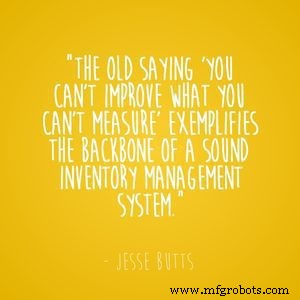
25. Track both inventory and sales data. “The old saying ‘you can’t improve what you can’t measure’ exemplifies the backbone of a sound inventory management system. If you haven’t yet started keeping thorough records, there’s no time like the present. As you create this records system, consider how it will accommodate the most vital inventory components:
- sales orders — documents comprising your customers’ purchase orders (requests for your product or service) in a format tailored for your business
- bills of materials — documents stating the inventory components (and hopefully labor) required to complete products or services
- work orders — if you’re involved in manufacturing, you’re probably familiar with these documents that include products’ details and their respective bills of materials
“You likely already have a system for recording transactions that includes sales orders (we hope). But most entrepreneurs haven’t taken the time to complete bills of materials, and for good reason:They are time-consuming. But, in the end, the benefits far outweigh the costs.
“Bills of materials are considerably easier to create for a retail storefront than for, say, a restaurant. In the food service industry, one sales order can relate to multiple bills of materials which, in turn, can require a few primary components and many others in small amounts. If you fall into the latter camp, determine the quantities of various invoice items needed for the appropriate bills of materials.” – Jesse Butts, How to Establish a Practical Inventory Management System , BizFilings; Twitter: @Toolkit
26. Check all stock inwards to account for errors in packing and other issues that may be missed if you simply assume the numbers match up. “The first focus should always be to check what actually gets delivered against what you have ordered from your supplier. It is so easy to assume that the numbers match up, but from talking to our customers we note that a good 1% to 2% of stock orders are incorrectly packed. If you just assume that you have the correct numbers of products when you add the inventory to your shelves you are liable to be short stocked when you receive a customer order. Another issue is that you might actually have more stock than you need and you won’t know when to reduce prices to move it or order more when you don’t need to.” – Stock Control and Inventory Management Tips , Cloud Fulfillment; Twitter:@CloudFulfillment
27. Centralize your data. “Regardless of how your inventory is set up physically, from a tracking perspective it should all be consolidated. This is especially the case if you have a web store and a physical one. Otherwise, you’ll appear disorganized and the process of buying could be confusing. As a bonus, being able to order online and either pick up or return in-store can seriously boost sales.” – 5 Tips for Streamlining Your Inventory Control Process , Blue Chip Inventory Service Int’l.; Twitter:@rodwalsh98
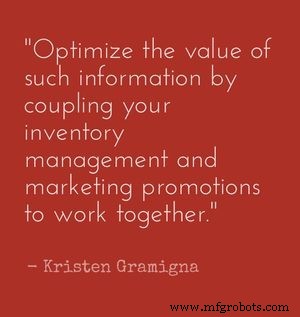
28. Inventory trends inform marketing plans. “Accurate inventory management incorporates what you know about customer and product demand from the past and present to (ideally) predict your best course of action in the future. A point of sale system can help quantify product level demand in tandem with recurring sales patterns, including those that fluctuate with some predictability (like seasonality, lifestyle occasions that impact your target audience and perhaps, local events).
“Optimize the value of such information by coupling your inventory management and marketing promotions to work together. For example, such insights can reveal potential opportunities to leverage quantity-based pricing vendors may offer, while at the same time empowering you to offset times of lower demand with promotions or ‘packaged’ deals that strategically drive sales, while moving the inventory that you acquired at a low cost.” – Kristen Gramigna, Keep Track of Your Precious Cargo:Tips for Inventory Management , Business.com; Twitter:@businessdotcom
29. Automate tracking with barcode labels and/or inventory management applications. “Another possible inventory management error is failure to track what you receive and what you sell. This can lead to losses, especially if you’re paying for products that are never showing up at your business, so some sort of tracking system is imperative. Automating the process with a barcode system and/or inventory management application is the smoothest way to handle this; note that the BizXpert app offers some useful inventory management features.
“Cycle counts are also recommended. Every day, pick a handful of items and count how many you have, comparing the number against what you have in your records. Pay special attention to big-selling and hot ticket items.” – Three Inventory Management Errors (And How to Avoid Them) , BizXpert; Twitter:@BizxpertApp
30. For many industries, including healthcare, inventory tends to follow the 80/20 rule. “Hospital inventory, like many things in life, often follows an 80/20 rule. 80% of the value of your inventory will be composed of just 20% of your actual product and most of those valuable items – whether they be assets, med-surg supplies, consignments or medication – fall into the departments of OR or Pharmacy. Plan your inventory efforts accordingly. Spend 80% of your time and energy optimizing the ordering and organization of the equipment, supplies and pharmaceutical products in these categories.” – Top 10 Tips for Hospital Inventory Management , Reliant Inventory Services
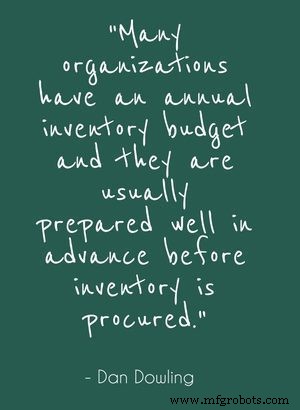
31. Inventory budgeting is a critical component of effective inventory control. “Many organizations have an annual inventory budget and they are usually prepared well in advance before inventory is procured. Budgets should include the total cost of ownership to keep inventory on hand during that year’s account period. This includes materials cost, fixed operational costs, carrying costs, logistics costs, redistribution costs and additional miscellaneous costs that contribute to the total costs of ownership.” – Dan Dowling, 6 Inventory Control Techniques for Stock Optimization , EazyStock Blog; Twitter:@EazyStock
32. When considering new inventory control software applications, be sure the cost is commensurate with functionality. “As you might expect, there are a lot of different types of inventory planning and control software out there. One of the biggest differences between many new solutions is whether they take advantage of cloud computing, or if they remain as locally installed software packages. For example, according to Inc.com , many providers of inventory control systems offer exclusively online, and full-service hybrid, versions of their software. The exclusively online versions are typically more limited in their functionality, while the full-service versions come with a higher price tag, but offer a greater number of services.” – Pat VanPutte, Inventory Control Systems Protect Your Bottom Line , NSA Computer Exchange Corp.; Twitter:@NSAComputerExch
Knowing Your Inventory and Your Company’s Needs
33. Don’t get caught with too much inventory. “Afraid of being caught short, it’s easy to spend too much on inventory, which can eat up working capital and erode profits. Warehousing isn’t free, of course, and inventory that sits on a shelf is subject to damage, depreciation, and even obsolescence. Old inventory can be very hard to move. Your options aren’t great,’ says Paul Huppertz, a logistics expert with The Progress Group, a supply chain consulting company based in Atlanta. ‘You may end up marking it down, selling to discounters, or shipping it to overseas liquidators.’
“To fix it: Start with some decent projections of how much supply you’ll need and when you’ll need it. The best gauge is what you’ve sold in the past. If you’ve sold 100 items per month for the past 12 months, chances are that you’ll need 100 this month. Then there’s seasonality:Do you usually see a fourth quarter spike with holiday sales? Or, if you’re in the home and garden business, do you see more activity in the spring selling season? ‘You can also identify and quantify less obvious patterns such as month-end spikes,’ says Huppertz.” – Lisa Girard, Five Steps to Painless Inventory Management , Entrepreneur; Twitter:@lisagjournalist
34. You should be able to break down your inventory into three basic categories:safety, replenishment, and excess or obsolete stock. “This breakdown makes it easier to make sound decisions about appropriate levels for each of these three areas. It helps determine the minimum safety stock needed to provide an insurance policy against supply chain problems either from manufacturing glitches or distribution uncertainties so that customers get what they ordered. It’s useful for pinpointing the amount of inventory required to replenish deliveries every two weeks. And it helps companies find ways to avoid a backlog of excess or obsolete inventory.” – Pratap Mukharji, Sam Israelit, Francois Faelli, Thierry Catfolis and Raymond Tsang, Ten ways to improve inventory management , Bain &Company; Twitter:@BainAlerts

35. Even with the most sophisticated automated data collection systems, a regular inventory audit is still valuable for keeping precise tabs on your inventory. “Make sure to regularly, on a monthly basis if possible, audit your inventory to sufficiently keep track of all of your stock. Even with all of the great technology available to us, we need to keep track of items and orders. This will help you to understand what is really selling and what is dead stock. Getting rid of dead stock is key to running an efficient warehouse operation. All you have to do is create a list of every product you have on your shelves – simple really.” – 5 Helpful Tips for Easy Inventory Control , Personal Finance and Business Advisor
36. Don’t be afraid to re-evaluate your company’s inventory control needs. “At what point do you realize that your approach to inventory management needs to change?
“Is it when you’re sending someone out for a 4-1/2-inch grinder and they’re gone over an hour?
“Or maybe it’s when you realize that you have hundreds of thousands of dollars—maybe millions—tied up in inventory, but you still don’t have exactly what you need the moment you need it.“If this sounds familiar, you’re not alone.“These are common practices in manufacturing environments where meeting production standards and schedules is the number-one priority, no matter what the cost. At some point, however, your finance department may recognize just how much time, money, resources and valuable shelf space is wasted on less–than–perfect inventory management practices. These days every company wants to streamline operations, improve productivity and gain that competitive edge. If you haven’t done it yet, re-evaluating your own inventory management system can help you accomplish some of these goals and significantly boost your bottom line.” – 5 Tips for Getting Started With Vendor-Managed Inventory , Grainger; Twitter:@grainger
37. A CMMS is the backbone of effective inventory management and control for facilities. “The CMMS is the backbone of inventory management and control. Besides the typical modules —work orders, equipment records, material stores inventory, project management, standard reports, work-scheduling databases — the CMMS query system can yield summary inventory reports that supervisors and managers need.
“When each work-order status indicates the material is available, the work order is ready to go, and the maintenance planner can schedule it with the confidence that a lack of materials will not delay the job. Managers also can monitor the trend of work orders awaiting material.
“With real-time inventory control, the need for physical inventory decreases, especially if entries are accurate and complete. Out-of-stock trends can alert the stores supervisor to specific items that need expediting before they lead to equipment downtime. Managers also can monitor inventory-valuation trends efficiently.” – Thomas A. Westerkamp, CMMS:Backbone of Inventory Management and Control , FacilitiesNet; Twitter:@Maintenance_Mag
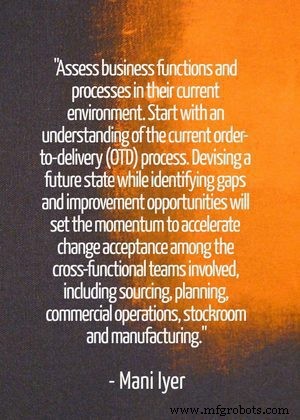
38. Conduct a business assessment. “Assess business functions and processes in their current environment. Start with an understanding of the current order-to-delivery (OTD) process. Devising a future state while identifying gaps and improvement opportunities will set the momentum to accelerate change acceptance among the cross-functional teams involved, including sourcing, planning, commercial operations, stockroom and manufacturing. Key activities in this stage should include:
- Study “As-Is” planning and execution process within the OTD process . Aim to have an unbiased assessment of current processes and practices. Start by interviewing a representative set of stakeholders who perform the same job within each function of the OTD process. Follow up with brainstorming sessions that involve key stakeholders from each function, which will help them understand their upstream and downstream process and address any issues arising out of lack of clarity of roles and responsibilities. These stakeholders should also voice their opinion on the desired “As-Is” state to establish a baseline against which improvements can be measured, and to effectively manage change through shared responsibility among their teams. Organizations should also consider conducting lean workouts among a cross-functional team of subject matter and Six Sigma process experts to understand redundant and non-value-added steps in the process due to multiple hand-offs between various functions within the OTD process.
- Summarize findings and gaps in data, process and practices. One of the ways to effectively capture the gaps in material planning and execution practices is through self-evaluation score sheets. A score sheet typically enlists the various planning and execution categories, and asks the functional owners to score according to the importance and effectiveness of each practice. Typical scoring criteria used is 1 (low), 5 (medium) and 9 (high) to clearly differentiate high impact gaps from lesser ones. For a more robust and objective view, third party service provider can also assist with benchmarking current processes against some of the best run companies in the industry.
- Devise “To-Be” planning and execution OTD process. Resource and system limitations may warrant a “To-Be Intermediate” state before moving to the ideal state. The objective is to outline a streamlined, robust and sustainable process that is aligned to the overall objective of optimizing inventory, customer service levels and variable costs. Organizations then begin to migrate to ideal state once resource and system limitations are addressed.
- Communicate to the whole group the identified improvement opportunities and goals . One of the biggest challenges faced during assessment is change resistance. Data-based inferences and identification of change catalysts is the key to driving fast adoption of more easily implemented improvements. By seeing immediate results, stakeholders will be better engaged to support additional and more sweeping process changes.” – Mani Iyer, Senior Business Manager, Genpact, Inventory Optimization:Five Steps to Improve Process Effectiveness , IndustryWeek; Twitter:@IndustryWeek
39. Understand your sales cycle and customer buying patterns to gain a better understanding of your customers. Effective inventory control is essential for customer service. “Inventory control is a customer service issue. Successful inventory management involves striking that balance between not having enough inventories on hand and having too much. Either you have the cost of excess inventory or the cost of a lost sale. It is painfully obvious which is lesser evil of the two.
“In order to conduct proper inventory control, you must have the ability to look at past sales and predict future demand. When forecasting your demand, you must learn from your past mistakes. Previous marketing promotions must be tracked closely to measure the impact of sales increases. Understanding your sales cycle and customer buying patterns will help you gain a greater understanding of your customers.” – James Ellis of Central Oregon Community College, Inventory Control:An Essential Element of Good Customer Service , Cascade Business News; Twitter:@cascadebusnews
40. Effective inventory control can reduce harmful consequences from mishaps such as the use of outdated or expired materials, such as those used in pharmacy preparations. “Large pharmacies, especially compounding pharmacies, often produce “stores of unwanted chemicals” used in the preparation of prescriptions. These chemicals are known as “bulk compounding chemicals,” and include substances such as tar, phenol and sulfur. Between the chemicals used to prepare prescriptions, pharmacies must also keep track of the compounds and drug products that are ingredients of the final medications. Given the many materials and types of chemicals used and produced, it is especially important for managers to use chemical inventory management systems to organize and keep track of the chemicals that enter and leave a facility.
“As mentioned above, the NECC used expired ingredients in their medications, which likely exposed a number of patients to adverse effects. Additionally, chemicals were not properly labeled. Using a chemical inventory management system prevents such oversight and in all likelihood, NECC lacked such a system. For compounding pharmacies and other such companies which would greatly benefit from tracking chemical supplies, let’s examine three ways a chemical inventory management system can help improve life for both employees and customers:
- Accurate data: The FDA has promised to clamp down on compounding pharmacies as a result of 2012’s incident; however, a random inspection should not be a reason to stress when facilities have a best practices chemical inventory management system in place. Many systems have gone completely digital by using barcode labeling and even providing remote inventory control. In this way, researchers and pharmacists can easily update inventory records, thus providing accurate and real-time data on the chemicals in stock.
- Expiration no more: Expired medications can be dangerous for patients; however, monitoring the expiration dates for both the chemicals used to produce prescription drugs as well as the chemical components of these drugs can be overwhelming. With a chemical inventory management system, managers can easily monitor expiration dates remotely, thus uncovering new opportunities for saving money by ordering less of a minimally used chemical, for example.
- Promote a safety culture: The most damning evidence against the NECC was its inability to create a culture of safety, one in which clear standards and practices are present and individuals are aware of the locations and proper disposal of items. The absence of such a culture perhaps helped contribute to the contamination of medications and it is no wonder that 14 former NECC executives and technicians were indicted on federal charges related to the outbreak. By implementing a chemical management system, leaders help ensure that employees understand the importance of safety and may act accordingly to protect the interests of all.
“What occurred at the NECC proved to be a fatal flaw for the company. Though the presence of a chemical management system may not have prevented the outbreak, if such a system were in place and used in conjunction with a digital notebook capable of recording the results of sterility tests, for example, the likelihood that such a mistake could occur would have been much less.” – Lilian N., Eliminating Harmful Substances Before They Reach Patients with Chemical Inventory Management , Biovia; Twitter:@3dsBIOVIA

41. If your company must maintain inventory for equipment repairs, consider parts that can be used in a number of applications. “If you store clamps and couplings that can be used in a number of applications, you won’t need to keep as many in stock and space is reduced. Full transition couplings that fit pipes of varying types and sizes within your water or wastewater infrastructure save space and help you stay prepared for multiple scenarios. There are also products that have the versatility to either join or repair pipes.” – David Wheat, Simple Steps For Inventory Control , Municipal Sewer &Water; Twitter:@MSWmagazine
Creating Effective Inventory Control Policies
42. Creating clear policies and processes allows your company’s inventory control function to run like a well-oiled machine. “It can be an uphill battle keeping your company’s inventory effectively organized and managed. There are some subtle nuances that are easy to overlook but should ultimately not be ignored. Compass Technologies, which provides retail point-of-sale, wholesale and distribution services to its customers, offers some helpful advice for inventory and organization management.
- Limit access to inventory. Only those who need to have their hands on inventory and inventory data should be allowed access.
- Establish well defined, user-friendly storage and receipt management policies. Check lists and data tables.
- Create an inventory system that utilizes multiple locations to replenish inventory from multiple sites – minimize distribution costs.
- Clearly map and label inventory areas, easy to read and understand with item descriptions.
- Track annual and seasonal regular inventory demand analysis. Use competitive data for start-up companies.
- Track and document inventory processes, including reviews.
- Inventory data base- GP and Add-On solutions.
- Use inventory alerts to make management aware of stock limits.
- Manage paperwork, purchase orders, receipts and inventory counts with GP for reporting.
- Utilize software add-on solutions to further manage the inventory process.” – Hillary Horning, Compass Technologies, 10 Tips for Smooth and Accurate Inventory Organization and Management , ERPSoftware Blog; Twitter:@erpsoftwareblog
43. All items should have an SKU, barcode, and product specifications. “Similar to a driver’s license, every product needs to have a unique ID number known as a SKU (Stock Keeping Unit). A SKU is vital for internal use as there will be instances where a particular product needs to be found quickly and having an SKU will make it easy to find. Additionally, having a SKU is imperative because another company could have a product named “Black Pants” exactly like and resellers are dealing with multiple vendors, thus creating a need to differentiate between similar products.
“Second, when working with other companies such as resellers whether it be an independent e-commerce store, a brick and mortar store or a big-box chain, a universal barcode/UPC number will be expected. A UPC number is another form of a SKU, but instead it comes in the form of a barcode which can be scanned and identified through a live database powered by GS1. Be cautious not to purchase UPC numbers from anywhere but GS1 or a valid reseller. The whole point of a barcode is to be scanned and looked up via a database, so having a barcode that brings up a different product from another company causes a lot of confusion and could potentially lose customers.
“Finally, it is always good to have a system for listing all your products specifications. Those specifications should have at least the following:
- Product Name
- SKU Number
- UPC Number
- Description
- Color
- Size
- Price
- Weight
- Dimensions (depending on product)” – Raad Mobrem, 6 Tips for Inventory Management , Small Biz Resources; Twitter:@SmallBiz_Help

44. Dedicated inventory control managers or other administrators should be tasked with handling the administrative tasks associated with inventory control, and these roles should be separate from accounting or finance departments. “There are many administrative tasks associated with stock control. Depending on the size and complexity of your business, they may be done as part of an administrator’s duties, or by a dedicated stock controller.
“For security reasons, it’s good practice to have different staff responsible for finance and stock.
“Typical paperwork to be processed includes:
- delivery and supplier notes for incoming goods
- purchase orders, receipts and credit notes
- returns notes
- requisitions and issue notes for outgoing goods
“Stock can tie up a large slice of your business capital, so accurate information about stock levels and values is essential for your company’s accounting.
“Figures should be checked systematically, either through a regular audit of stock – stocktaking – or an ongoing program of checking stock – rolling inventory.
“If the figures don’t add up, you need to investigate as there could be stock security problems or a failure in the system.
“Health and safety aspects of stock control are related to the nature of the stock itself. Issues such as where and how items are stored, how they are moved and who moves them might be significant – depending on what they are.
“You might have hazardous materials on your premises, goods that deteriorate with time or items that are very heavy or awkward to move.” – Stock Control and Inventory , Info Entrepreneurs; Twitter:@chambremontreal
45. Make inventory accuracy a higher priority than order fulfillment. “Raising the priority of accurate inventory is perhaps the most important, yet most difficult, step in inventory accuracy. Many inventory problems arise from pushing a transaction through the system with the intent of going back and fixing the numbers later. In the rush of other emergencies, however, we often forget to go back and correct the numbers in the system. This leads to missed production entries, negative lines of inventory, and a whole mess of other problems. Only by putting systems in place that will prevent an employee from moving forward without the necessary system transaction can you effectively keep accurate records of inventory.
“One example of success that my team recently implemented was changing our accounting system so that it will not process any shipment that contains more inventory than we have on hand. For example, if we’re trying to ship 15 of an item, but our system says we only have 5 in stock, then an alert will pop up and force us to fix the problem before moving forward. This helps us address problems before the product goes out the door. By forcing us to address missed production entries before the product leaves, our modified system helped us eliminate most of our major inventory issues.” – Alex Fuller, 10 Tips to Make Physical Inventory Counts Less Painful and More Accurate , Supply Chain Cowboy
46. Inventory management software is a valuable tool and superior to outdated spreadsheet methods. “Using the right tools for the job is a must. Many companies choose spreadsheets for inventory management software because it seems like the familiar and easy thing to do. Unfortunately, spreadsheets come with built-in risks:it’s far too easy to lose changes or accidentally delete a spreadsheet file. It’s also difficult for multiple people to synchronize their spreadsheets, which further increases the risk for error. Find a low-cost but effective software for managing your inventory, such as Peachtree or QuickBooks. Most organizations overlook these options for inventory management because they’re best known for their accounting features. However, they offer invaluable inventory management software features and a central database to streamline inventory operations, increase accuracy, and minimize the possibility of error.” – 5 Supply Chain Management Inventory Tips , Women’s Distributor Services (WDS); Twitter:@WDSJennifer
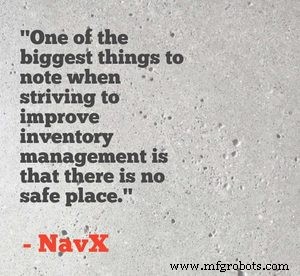
47. Optimizing inventory control requires continuous improvement. “One of the biggest things to note when striving to improve inventory management is that there is no safe place. Maintaining the right balance of inventory levels, properly organizing your warehouse for maximal efficiency, and ensuring that you have complete insight into your processes will go a long way in helping you improve effective inventory management however when you think you’ve succeeded, the worst thing you can do it sit back and relax. Taking a critical approach to operations, including inventory management, is fundamental to maintaining your competitive edge. Be sure to monitor costs as well as performance; if you see that inventory carrying costs are rising, maybe your forecasting isn’t as accurate as it could bet. If customer satisfaction falls, take a look at your order history. If you’re sending out incomplete orders, or items aren’t being sent to customers in a timely manner, dig a little bit deeper. By building the philosophy of continuous improvement into your organization and your inventory management strategy, you will be able to achieve greater efficiency and profitability.” – 3 Tips for Improved Inventory Management , NavX; Twitter:@NAVX_software
48. Cycle counts can be a useful alternative to stock-wide physical inventory counts. “Cycle-counts have become SOP with a growing number of mid-sized firms since more business software packages now provide this functionality. The benefits of employing a cycle-count regimen over periodic stock-wide physical counts are great. Cycle-counts are less disruptive to operations, offer greater specificity in determining what items should be counted and generally force greater discipline into the organization’s inventory management.” – Tips for Improved Inventory Control:Part 5/8 , TBS Automation Systems
49. Take steps to maximize both your profit and resources by involving team members and distributors in key processes. “There are many best practices that any Supply Chain Manager should follow, but a few of the strategies that tend to ensure maximizing not only profits but resources needed include:
- Working with your team and distributor to maximize service and savings; everyone should be clear on the expectations of the strategy you have defined.
- Once strategy is implemented continue consistent monitoring of purchasing behaviors. Many times a focus on efficiencies over time begins to become complacent resulting in overpayment for suppliers and an increase in overall supply chain costs.
- Understand the difference between “cost” and “price.” Many times, the manufacturer costs revealed for the savings analysis do not include the distributor mark-up, holding costs, or the freight costs. Also remember to keep in mind that being able to secure products through a manufacturer directly needs to apply to all of their products in that category, not just one of the more highly utilized items.
- Establish your ability to purchase in the lowest unit of measure. This will ensure that you are not over-ordering on products you may not use frequently or on any consistent basis.
- Be sure of what your GPO compliance requirements are. [This] includes not only volume in units, but may also include dollar-volume commitments. It is important to remember that reducing your pricing on actual supplies may interfere or require an amendment to your GPO agreement in order to maintain compliance. Many times hospitals secure agreements that include commitment to process a set dollar volume through the GPO base agreements that must be fulfilled to maximize the benefits of the entire portfolio.” – Lori Pilla, Vice President, Amerinet Clinical Advantage and Supply Chain Optimization, Amerinet Inc., St. Louis, as quoted in More inventory management best practice tips , HPN Online; Twitter:@HPN_Online, @AmerinetInc
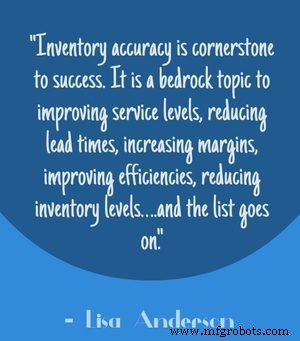
50. Follow best practices for conducting physical inventory counts. “Inventory accuracy is cornerstone to success. It is a bedrock topic to improving service levels, reducing lead times, increasing margins, improving efficiencies, reducing inventory levels….and the list goes on. Although I recommend implementing cycle counting programs as a way to replace physical inventories, there are times when a physical inventory is a must. Thus, it is worth thinking about a few tips to successfully complete a physical inventory.
- Prepare, prepare, and prepare: 80% of your success is in preparation. Organize the warehouse, clearly mark areas, label exceptions, complete and review system transactions, etc.
- Stop/isolate movement: When you begin your physical count, stop all physical and system movements and transactions. This is a critical foundation – similar to building a house, if you start adding windows prior to finishing the walls, the house might begin to fall apart.
- People and communication: Make sure the right people are in the right jobs for their skill sets. And, communicate, communicate, communicate. Make sure everyone has clear instructions, understands how to get questions answered, etc.
- Manage the control desk: This is the term I’ll use for the team organizing and controlling the process – the Grand Central Station hub. Typically, this person/team keeps track of count sheets, makes sure everything “adds up”, answers questions and keeps the process moving.
- Metrics/tracking progress: Putting the key metrics and vehicles in place to track progress is cornerstone to success. By reviewing these metrics, the leader can review progress, make adjustments as required and keep the process on track. Metrics also provide for a way to measure success.” – Lisa Anderson, Tips for Physical Inventory Success , LMA Consulting Group; Twitter:@LisaAndersonLMA
51. Give your employees tools that make them more efficient, which leads to more accurate inventory control. “Other than employees, inventory is a company’s largest asset. Reducing inventory levels and increasing inventory turns can lead to immediate savings on a company’s bottom line. Also, it’s important to consider the “landed cost” of your products. While your supplier may have a book price with bulk discounts, consider how much the product actually will cost you from the time you purchase it to the time it lands at your warehouse dock. Cargo fees, customs, and transportation add up quickly and can shrink profit margins. To navigate these challenges, consider these five tips:
- Reduce compounded safety stock: Most companies keep an extra cushion of inventory to account for unexpected demand. The problem is that when every vendor in a supply chain (raw material supplier, manufacturer, retailer) maintains that extra 5 percent to 10 percent of cushion, it adds up to unnecessary costs for each organization. The key is to communicate closely and often with your suppliers and trading partners to prevent overproduction and increased carrying cost for them. Find ways to collaborate and eliminate excess safety stock.
- Give employees tools to make them more efficient: In tough times, high-quality employees that you strive to retain can get burned out. They likely will absorb the duties of their more expendable colleagues. One way to keep them happier and more productive is to give them the technology tools that will make their jobs easier. Technology that automates tasks or offers predictive models about supply and demand will help reduce the manual aspects of their jobs, so they can focus on driving sales or broader strategies to help grow your business.
- Optimize your inventory: Simply said, you need to get rid of the inventory you don’t sell and get more of the inventory you do. The concept sounds straightforward but many small and midsize businesses have the wrong mix of inventory. While it may be painful to liquidate the inventory you spent precious resources to secure, having it take up warehouse space and require your team to manage it will cost you more in the long run. That space and mindshare could be spent on inventory that is hot and will turn over quicker, and that means more profit in your pocket. Take the short-term hit and implement a system that sheds products that don’t sell and invest in those that do.
- Focus on banner products: Growing up, there were just three kinds of soap at the grocery store:Dove, Dial, and Lava. Now a visit to the soap aisle could add another 15 minutes to a shopping trip because there are just too many choices. By adding variations to your product line versus introducing completely new and different products, you actually cannibalize your own sales and risk confusing customers to the point of apathy. Concentrate on your best products and create customer brand loyalty, which will create “customers for life” versus fickle ones.
- Manage to the future: Understand that in today’s economic climate, cash is king. If you are sitting in a good position, make cutbacks to your spending but invest in tools and people that will help you in the long run to grow your business and drive greater efficiency. With layoffs and companies eager to keep sales high, you can secure some top quality talent and excellent deals on the technology tools you need.
“In times like these, it is key to stay positive but manage realistically, cutting short-term costs that you can afford to cut. The important thing is to understand which assets are mission-critical and which ones need to be shed. Properly managing the No. 1 or No. 2 asset of your company will allow you to cut expenses and increase sales.” – Bill Harrison, Top Five Tips to Rescue Your Business with Inventory Management , AllBusiness; Twitter:@AllBusiness_com
Asset Tracking Solutions from Camcode:
- 库存控制
- 库存管理
- Custom Foil Labels
- 仓库标志
- 过道标志
- Stainless Steel Tags
- 地板标签
- 安全标签
- 磁性标签
工业技术


